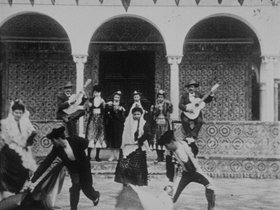
I just completed a translation and edit of Stereotypes and Archetypes in Early Spanish Cinema by Francisco Griñán for the New Review of Film and Television Studies. The paper is a case study of how national archetypes and stereotypes get put into place.
The New Review rarely prints images, so I am posting some images here relating for the earliest films ever shot in Spain. Some of these films were made by Lumière operators as early as 1897. Alice Guy spent six weeks traveling around Spain making silent and synchronized sound films (phonoscenes for the Chronophone) in 1905. All of us interested in early cinema owe a huge debt to Griñán for dedicating ten years of his life to his research on early cinema in Spain.
The first films in Spain were shot by Lumière operator Alexandre Promio in Madrid in 1896. The earliest surviving Lumière films shot in Spain, by an unidentified film operator, are these, filmed in Seville in 1898: scenes of Holy Week (Procession à Séville I, II and III, No. 857-859), views of the Andalusian city (Rue à Séville, 855, and Foire de Seville, 856) and several bullfighting films (Transport of cages, 860; École de tauromachie, 861, and Running of the bulls, 862).
The same film operator also shot the actuality series Danses espagnoles, numbered in the original catalogue from 843 to 854. These films exist, but I have not seen them, nor is video publicly available. Here are some images (this is the source):Lumiere 843 El Vito
Lumiere 844 Estrella de Andalucia
Lumiere 845 La Jota
Lumiere 846 Boleras robadas (ensemble)
Lumiere 847 Bolero de medio pas
Lumiere 848 Las Peteneras
Lumiere 849 Las Manchegaa
Lumiere 850 Boleras Robadas (deux)
Lumière 851 La Malagueña y el torero
Lumiere 852 Bolero de medio paso - ensemble
Lumiere 853 La sal de Andalucía
Lumiere 854 El olé de la Curra